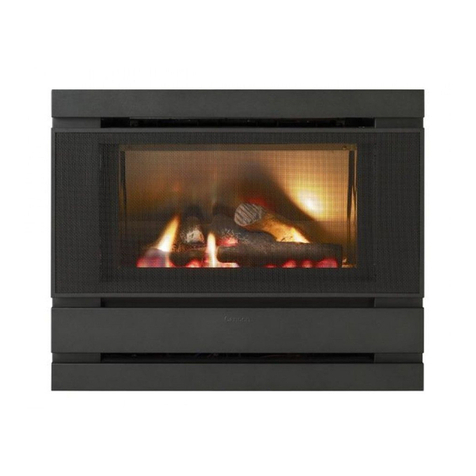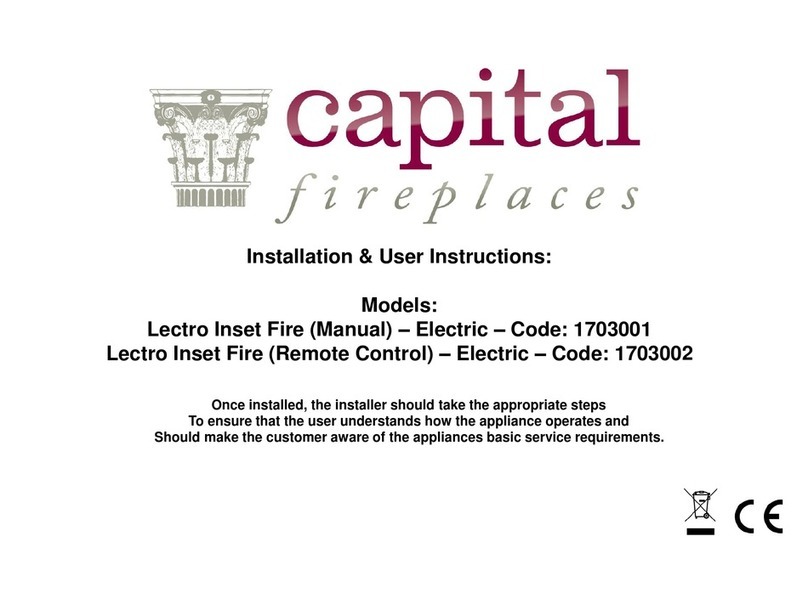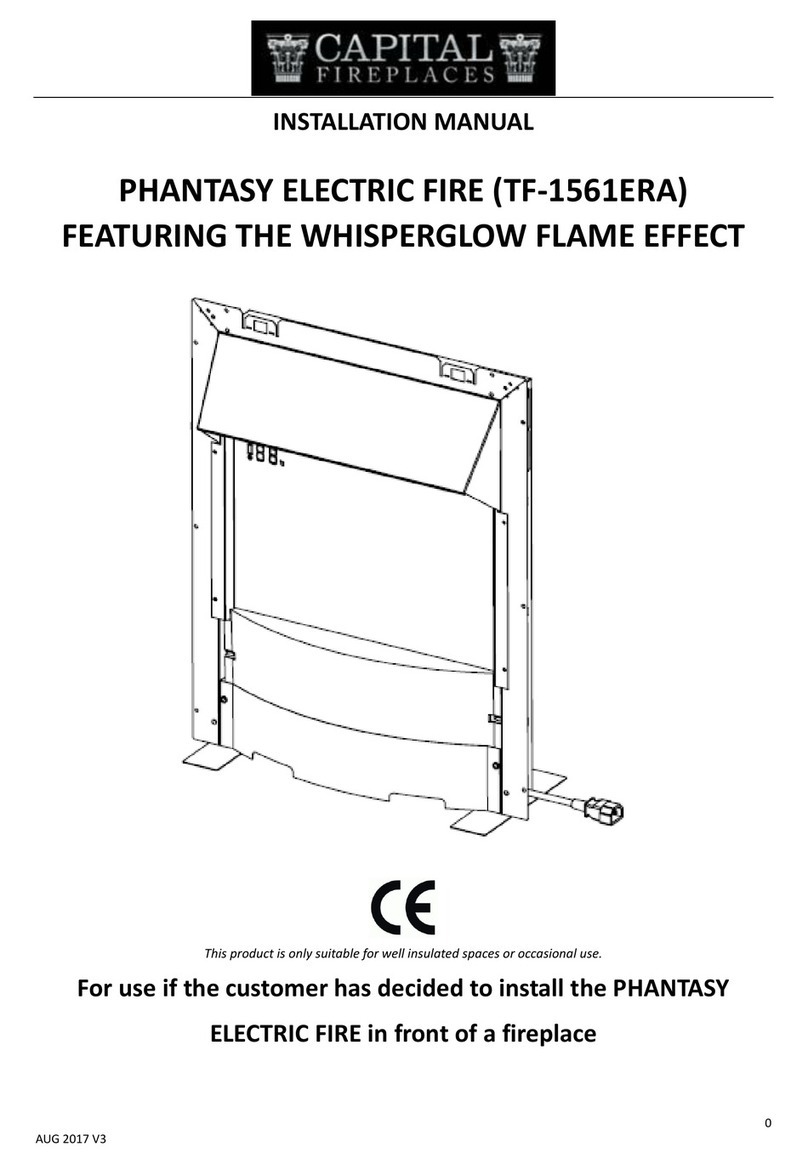Sirius MF&WD Version 1 November 2013
Sight of the data plate that should have been fitted by the approved installer.
Proof of installation by HETAS or other approved body, or letter from Building Control confirming that the
installation was installed in accordance with the Building Regulations
Proof of purchase from an approved supplier
Proof of annual sweeping of chimney, at which time an inspection as to the condition of the chimney should be
carried out to allow for necessary maintenance to be performed.
Use only recommended fuels. See pages 15 and 16 for recommended fuels.
Capital Fireplaces Ltd will accept no responsibility for installations which have been carried out that are not in
accordance with the Building Regulations or if the conditions stated in the stove instructions are not adhered to.
This guarantee applies to parts only and excludes labour costs.
In no event shall Capital Fireplaces Ltd be liable for special, incidental or consequential damages, injury to persons,
damage to property or any other consequential loss.
Installation, Operation and Maintenance
IMPORTANT: THIS APPLIANCE MUST BE INSTALLED BY A COMPETENT PERSON AND THE INSTALLATION MUST COMPLY WITH BS8303 –CODE OF
PRACTICE FOR INSTALLATION OF DOMESTIC HEATING AND COOKING APPLIANCES BURNING SOLID MINERAL FUEL, NATIONAL BUILDING
REGULATIONS, LOCAL BY-LAWS AND STANDARDS AND THE REQUIREMENTS OF THE HEALTH AND SAFETY AT WORK ACT - IN PARTICULAR:
HANDLING –ADEQUATE FACILITIES MUST BE AVAILABLE FOR LOADING, UNLOADING AND SITE HANDLING
FIRE CEMENT –SOME TYPES ARE CAUSTIC AND SHOULD NOT BE ALLOWED TO COME INTO CONTACT WITH THE SKIN. IN CASE OF CONTACT WASH
IMMEDIATELY WITH PLENTY OF WATER
ASBESTOS –THESE STOVES CONTAIN NO ASBESTOS. IF THERE IS A POSSIBILITY OF DISTURBING ANY ASBESTOS IN THE COURSE OF INSTALLATION
THEN PLEASE SEEK THE GUIDANCE OF A SPECIALIST AND USE APPROPRIATE PROTECTIVE EQUIPMENT.
METAL PARTS –WHEN INSTALLING OR SERVICING THIS STOVE CARE SHOULD BE TAKEN TO AVOID THE POSSIBILITY OF PERSONAL INJURY
UNLESS THE INSTALLER IS QUALIFIED TO APPROVE INSTALLATION THEN APPROVAL MUST BE SOUGHT FROM YOUR LOCAL BUILDING CONTROL
DEPARTMENT. THE SUPPLIERS ACCEPT NO RESPONSIBILITY IF THIS ADVICE IS NOT FOLLOWED. THIS APPLIANCE HAS BEEN EXTENSIVELY
TESTED FOR SAFETY AND EFFICIENCY, DO NOT ATTEMPT TO MODIFY IT. ALWAYS USE GENUINE REPLACEMENT PARTS AS RECOMMENDED BY
YOUR SUPPLIER. FAILURE TO ADHERE TO THIS ADVICE WILL INVALIDATE YOUR GUARANTEE.
TRY TO AVOID FITTING AN EXTRACTOR FAN IN THE SAME ROOM AS THIS STOVE. IF THIS IS UNAVOIDABLE THEN SEEK SPECIALIST ADVICE TO
ENSURE THAT THE INSTALLATION IS TESTED FOR SAFETY. A SUITABLE TEST COMPRISES CHECKING FOR SPILLAGE IF THE ROOM WHERE THE
APPLIANCE IS FITTED IS SUBJECTED TO THE GREATEST POSSIBLE DEPRESSURISATION. THIS MEANS FIRING THE APPLIANCE WITH ALL THE
EXTRACT FANS IN THE BUILDING OPERATING AT THEIR MAXIMUM AND WITH ALL DOORS, ADJUSTABLE VENTILATORS AND WINDOWS CLOSED.
IF SPILLAGE OCCURS THEN ADDITIONAL PERMANENT VENTILATION DIRECT FROM OUTSIDE WILL BE REQUIRED. ONCE THE ADDITIONAL
VENTILATION IS FITTED, RETEST AS NOTED ABOVE,
IT IS ESSENTIAL AND REQUIRED BY BUILDING REGULATIONS THAT A CARBON MONOXIDE (CO) ALARM IS INSTALLED IN THE SAME ROOM AS
THIS STOVE.
THIS STOVE MUST HAVE ITS OWN CHIMNEY AND MUST NOT SHARE A CHIMNEY WITH ANOTHER APPLIANCE.
THIS STOVE IS FOR INTERMITTENT USE ONLY AND SHOULD NOT BE SHUT DOWN OVERNIGHT
VENTILATION MAY BE REQUIRED INTO YOUR ROOM, PLEASE SEE PAGE 10.
Installation































